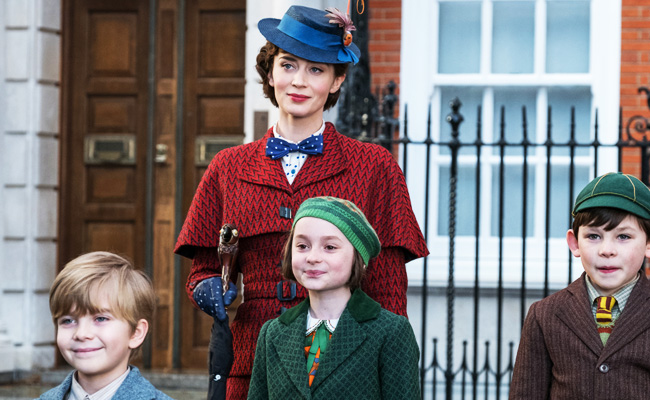
If there’s one aspect of Mary Poppins Returns that stands out, it’s Emily Blunt, whose cheerfully clipped, winningly icy portrayal of the titular nanny is like a nice squeeze of acid to brighten up a schmaltzy dish. Blunt’s Mary is the beau ideal of English restraint, exuding elegance and tantalizing mystery rather than repression — like Paddington, a kind of superhero of Britishness.
As for the rest of the movie, well, it feels a lot like one of those network live musical events, where the girl from Girls plays Peter Pan or whatever. Broadly but mildly appealing to all ages, and mostly an excuse to watch actors you know sing songs you enjoy and generally be reminded of things. Not that there’s especially anything wrong with that, but the frustrating thing about Mary Poppins Returns is that it’s constantly teasing us with something more.
In this update, directed by Rob Marshall (Chicago, Nine, Into the Woods) and written by David Magee (Life Of Pi, Finding Neverland), Ben Whishaw and Emily Mortimer play Michael and Jane Banks, grown-up versions of the children from the 1964 Julie Andrews version. Michael’s wife has died†, leaving him to raise their three young children, John, Anabel, and Georgie, and to make matters worse, the finances are in disarray and the bank, represented by pocket watch-clutching capitalist William Wilkins (Colin Firth), has demanded he pay off their home loan in full by midnight Friday or else the family home will be repossessed.
(†Between Searching, To All The Boys I’ve Loved Before, and Eighth Grade, the off-screen dead mom has done some heavy lifting in 2018.)
Periodically Mary Poppins Returns flirts tantalizingly with social relevance. At the outset, we’re told the story takes place during the Great Slump, the British name for the Great Depression. With Colin Firth playing a greedy banker looking to repossess the family home based on shady paperwork, you don’t have to squint too hard to find contemporary parallels. The film also takes great pains to remind us every 10 minutes or so that Jane, Emily Mortimer’s character, is a labor organizer, though it’s never entirely clear how this affects anything else that happens.
Jane’s labor organizing is a Chekhov’s Gun never fired. Mary Poppins Returns has all the ingredients for something interesting: a greedy banker, mortgage fraud, a labor organizer, a struggling family, and a character who seems to represent the working class. That last one being Jack, played by Hamilton‘s Lin Manuel-Miranda, a lantern lighter (“leerie”) and sort of an updated version of Dick Van Dyke’s Mr. Dawes, a kind of narrator/presenter/all-knowing emcee.
Jack feels superfluous in this version. It seems Lin Manuel-Miranda is meant to serve as mainstream America’s ambassador to musical theater, and fine, but narratively, Jack is mostly a distraction. Whereas Blunt’s icy (but loving) detachment is the perfect foil for Disney magic and musical camp, Miranda’s overly ingratiating charm borders on smarm. In every scene he smirks like he already knows the ending. And in a movie full of on-point accents, Miranda’s campy, SHOYNE YA BOOTS, GUVNA take on Cockney sticks out like a broken piano string (maybe it’s an homage to Dick Van Dyke?). It’s only when he finally gets to rap (or fast sing, anyway) that Miranda finally seems in his element, his broad expressions complementing the rapid-fire lyrics. That lasts for about the bridge of one song.
As for the character, Jack’s team of “leeries” come in handy in exactly one scene — this despite the burgeoning and frequently commented-upon relationship between him and the labor organizer. And just before that scene, Jack leads the leeries in a song whose lyrics include “when it’s foggy/don’t complain.”
That’s the main trouble with Mary Poppins Returns; the songs don’t especially advance the plot or voice the themes. In a story about a corrupt boss using a financial crisis to screw one of his workers out of his house, the magical servant and musical lamp lighter team up with a labor organizer to sing… well, mostly songs about positive thinking and believing in magic. Which sounds to me a lot like “buy more Disney stuff.”
The climax hinges on about one part collective action and three parts destiny. This strategy of passive wishing cuts directly against Mary Poppins’ entire character, which is all about speaking up, correcting improper behavior, and self-advocating without seeming like an asshole. Her persona contains a valuable lesson that the film itself doesn’t voice.
Moreover, does someone always have to be a secret princess in these things? Surely there’s a way to make children feel like they’re all individually special without venerating the ideas underpinning monarchy. Black Panther and The Last Jedi proved it could even be done in a Disney movie. “Smile and hope your grandpa was a secret millionaire” just isn’t that exciting an action plan (I’ve done it, doesn’t work).
I certainly wouldn’t expect such things in an average Disney rehash, and it’s to Mary Poppins Returns‘ credit that I ended up wanting more than the big numbers and surprise cameos it offers. Though it’s still disappointing that it doesn’t really come through.
Vince Mancini is on Twitter. You can find his archive of reviews here.






